1993 CHEVROLET SUBURBAN service
[x] Cancel search: servicePage 317 of 386
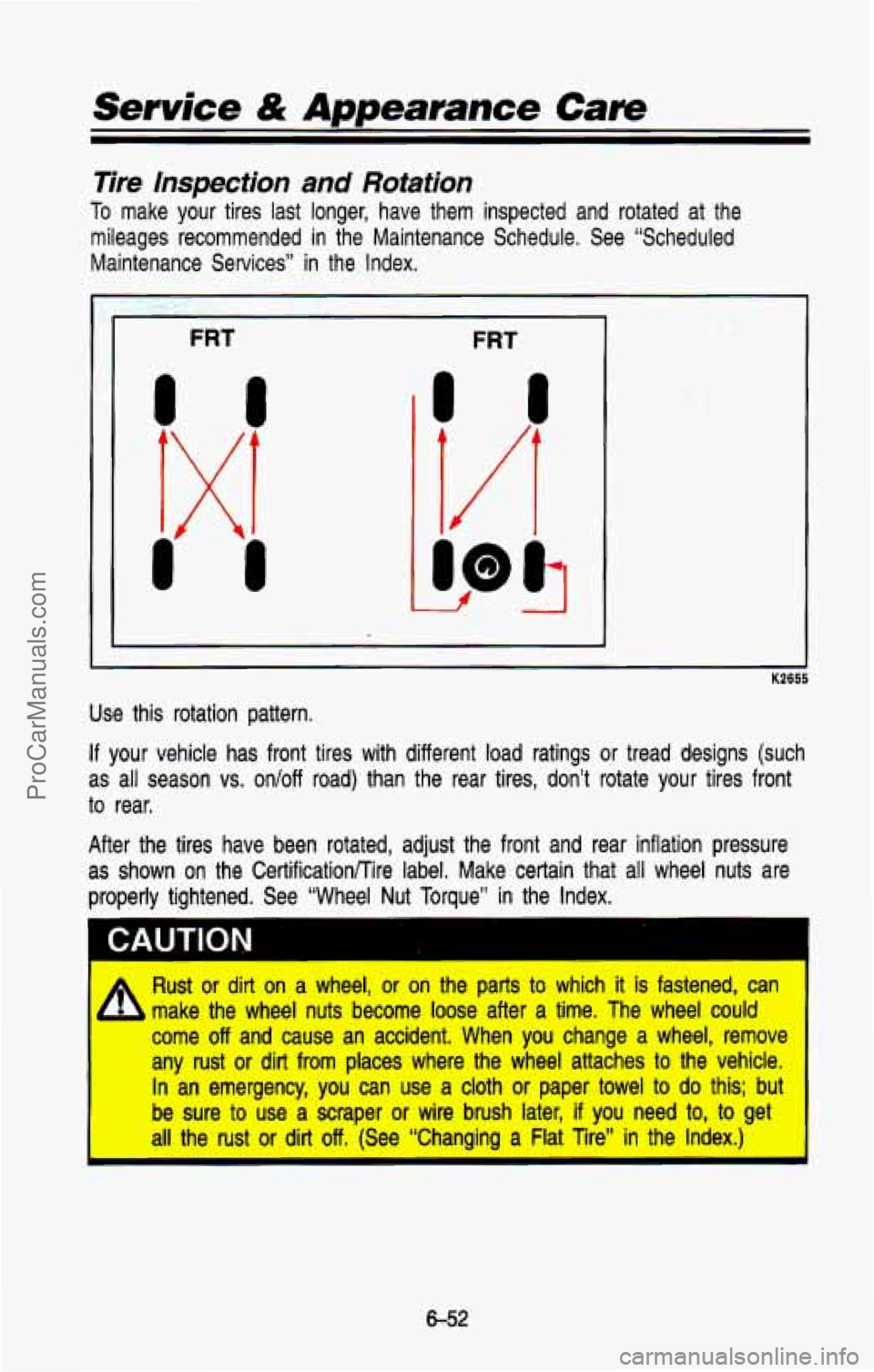
Service & Appearance Care
Tire lnspecfion and Rotation
To make your tires last longer, have them inspected and rotated at the
mileages recommended in the Maintenance Schedule. See “Scheduled
Maintenance Services” in the Index.
FRT FRT
L
I I
K2655
Use this rotation pattern,
If your vehicle has front tires with different load ratings or tr\
ead designs (such
as all season vs. on/off road) than the rear tires, don’t rotate \
your tires front
to rear,
After the tires have been rotated, adjust the front and rear \
inflation pressure
as shown on the CertificationRire label. Make certain that all \
wheel nuts are
properly tightened.
See “Wheel Nut Torque” in the Index.
1 CAUTION
Rust or dirt on a wheel, or on the parts to which it is fastened, can
make the wheel nuts become loose after a time. The wheel could
come
off and cause an accident. When you change a wheel, remove
any rust or dirt from places where the wheel attaches
to the vehicle.
In an emergency, you can use a cloth or paper towel to
do this; but
be sure to use a scraper or wire brush later, if you need to, to get
I
I all the rust or dirt off. (See ‘Changing a Flat Tire” in the Index.) I
&52
ProCarManuals.com
Page 318 of 386
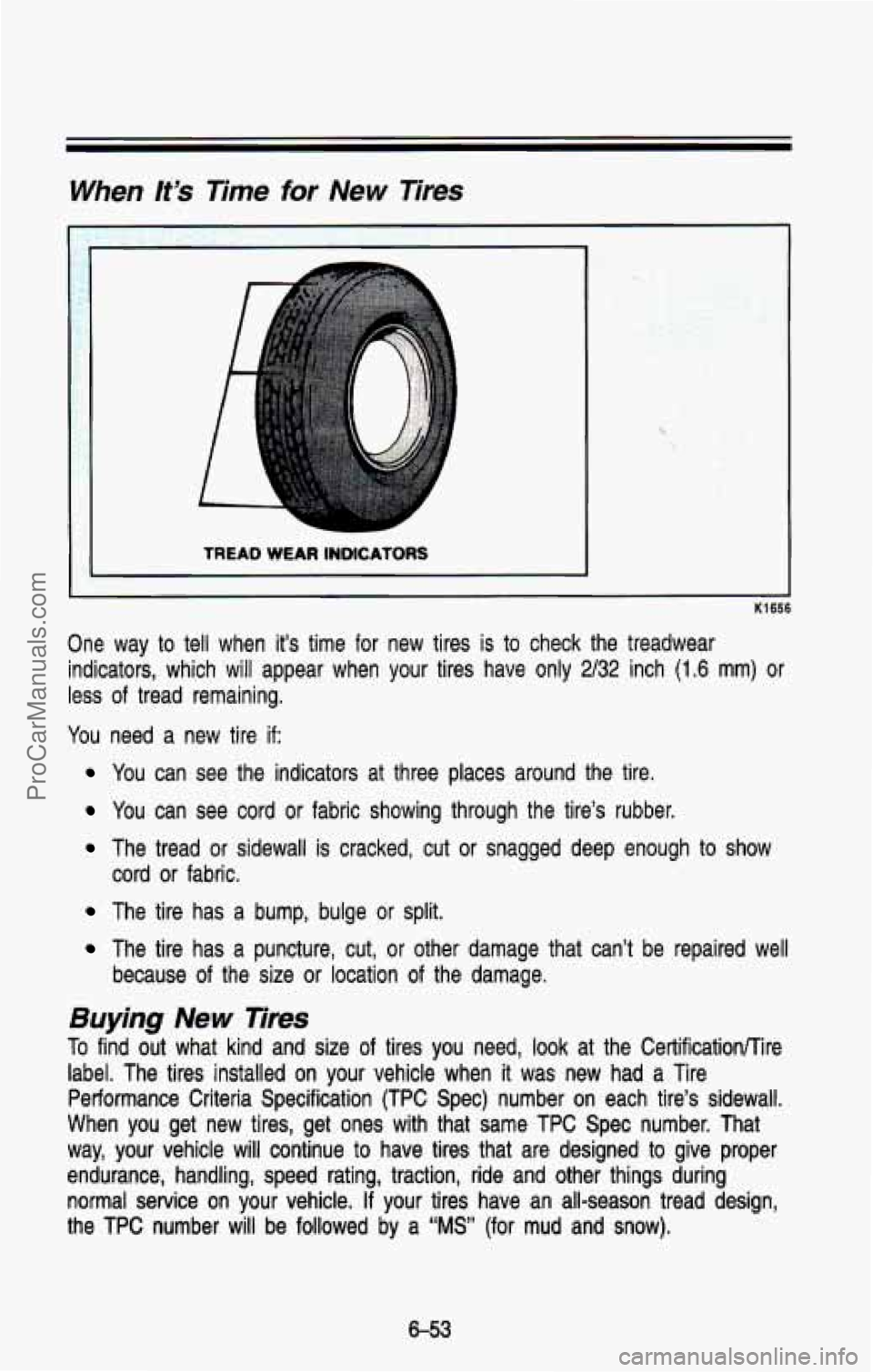
When It’s Time for New Tires
TREAD WEAR INDICATORS
K1656
One way to tell when it’s time for new tires is to check the treadwear
indicators, which will appear when your tires have only
2/32 inch (1,6 mm) or
less of tread remaining.
You need a new tire if:
You can see the indicators at three places around the tire.
You can see cord or fabric showing through the tire’s rubber.
The tread or sidewall is cracked, cut or snagged deep enough to show
The tire has a bump, bulge or split.
cord
or fabric.
The tire has a puncture, cut, or other damage that can’t be repaired well
because of the size or location of the damage,
Buying New Tires
To find out what kind and size of tires you need, look at the Certificationnire
label. The tires installed on your vehicle when it was new ha\
d a Tire Performance Criteria Specification (TPC Spec) number on each t\
ire’s sidewall.
When you get new tires, get ones with that same TPC Spec num\
ber. That
way, your vehicle
will continue to have tires that are designed to give proper
endurance, handling, speed rating, traction, ride and other thin\
gs during normal service
on your vehicle. If your tires have an all-season tread design,
the TPC number
will be followed by a “MS” (for mud and snow).
6-53
ProCarManuals.com
Page 319 of 386
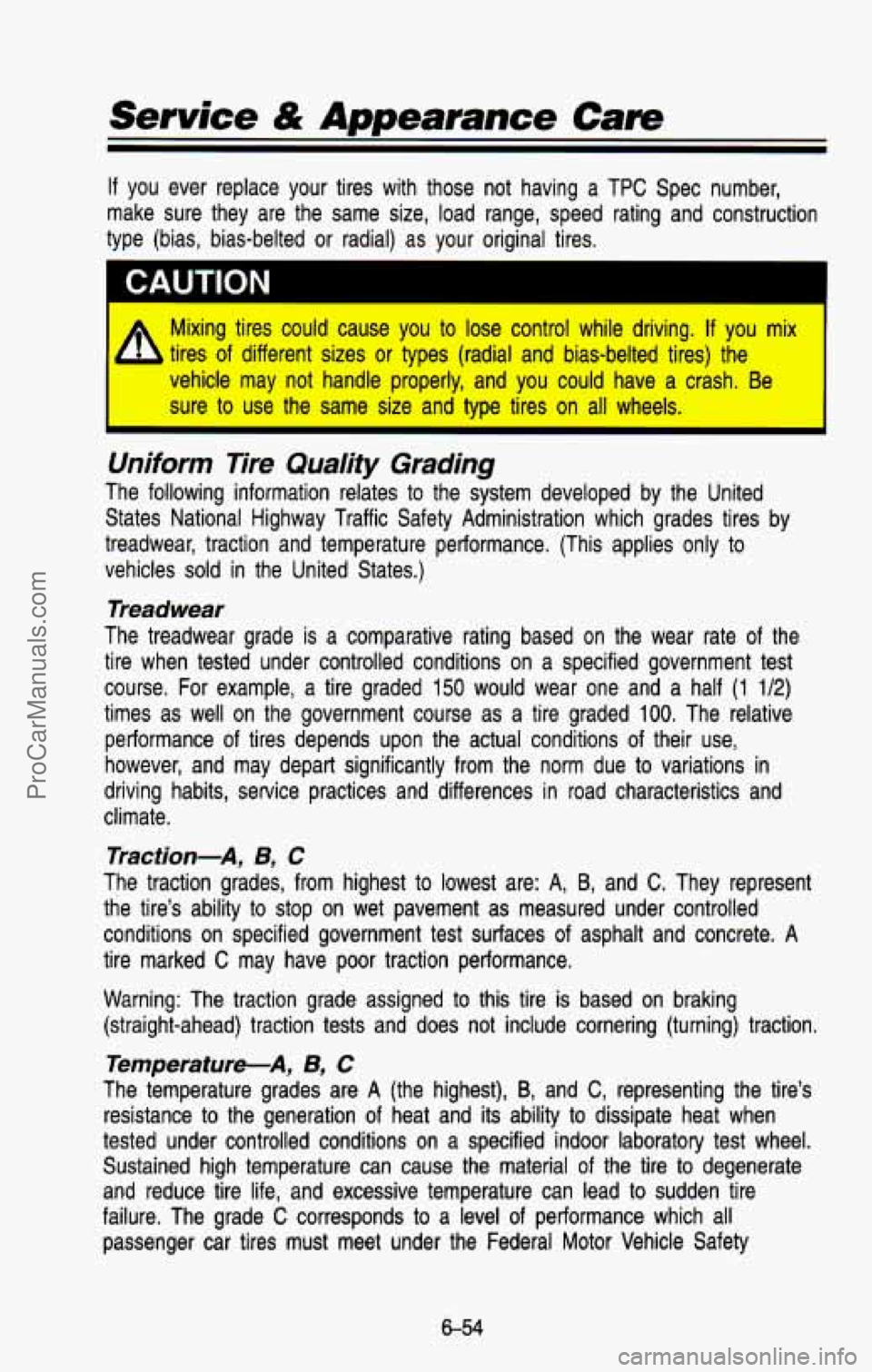
Service & Appearance Care
If you ever replace your tires with those not having a TPC Spec number,
make sure they are the same size, load range, speed rating an\
d construction
type (bias, bias-belted or radial) as your original tires.
I CAUTION
A
Mixing tires could cause you to lose control while driving. If you mix
tires
of different sizes or types (radial and bias-belted tires) the
vehicle may not handle properly, and you could have a crash. Be
sure
to use the same size and type tires on all wheels.
I
Uniform Tire Quarity Grading
The following information relates to the system developed by the United
States National Highway Traffic Safety Administration which grade\
s tires by
treadwear, traction and temperature performance. (This applies o\
nly to
vehicles sold in the United States.)
Treadwear
The treadwear grade is a comparative rating based on the wear \
rate of the
tire when tested under controlled conditions on a specified government test
course.
For example, a tire graded 150 would wear one and a half (1 1/2)
times as well on the government course as a tire graded 100. The relative
performance
of tires depends upon the actual conditions of their use,
however, and may depart significantly from the norm due to var\
iations
in
driving habits, service practices and differences in road characteristics and
climate.
Traction-A, B, C
The traction grades, from highest to lowesr are: A, 8, and C. They represent
the tire’s ability to stop on wet pavement as measured under controlled
conditions on specified government test surfaces of asphalt and concrete. A
tire marked
C may have poor traction performance.
Warning: The traction grade assigned to this tire is based on braking
(straight-ahead) traction tests and does not include cornering \
(turning) traction.
Temperature-A, B, C
The temperature grades are A (the highest), B, and C, representing the tire’s
resistance to the generation
of heat and its ability to dissipate heat when
tested under controlled conditions on a specified indoor laborat\
ory test wheel.
Sustained high temperature can cause the material
of the tire to degenerate
and reduce tire life, and excessive temperature can lead to sudden tire
failure. The grade
C corresponds to a level of performance which all
passenger car tires must meet under the Federal Motor Vehicle \
Safety
6-54
ProCarManuals.com
Page 323 of 386
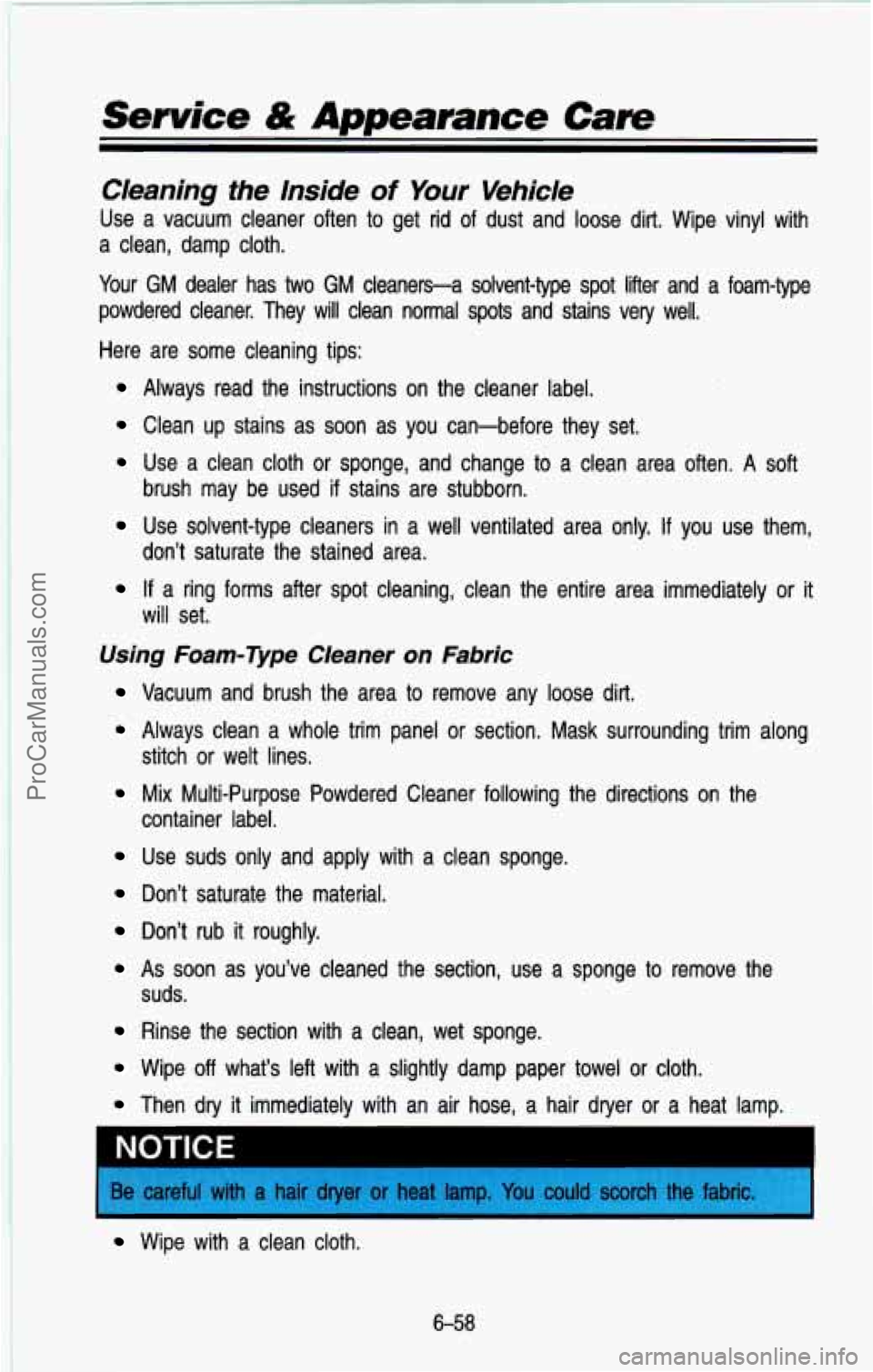
Service & Appearance Care
Cleaning the Inside of Your Vehjcle
Use a vacuum cleaner often to get rid of dust and loose dirt\
. Wipe vinyl with
a clean, damp cloth.
Your GM dealer has
two GM cleaners-a solvent-type spot lifter and a foam-type
powdered cleaner. They will clean normal spots and stains very \
well.
Here are some cleaning tips:
Always read the instructions on the cleaner label.
Clean up stains as soon as you can-before they set.
Use a clean cloth or sponge, and change to a clean area often. A soft
brush may be used
if stains are stubborn.
Use solvent-type cleaners in a well ventilated area only. If you use them,
don’t saturate the stained area.
If a ring forms after spot cleaning, clean the entire area immedi\
ately or it
will set.
Using Foam-Type CIeaner on Fabric
Vacuum and brush the area to remove any loose dirt.
Always clean a whole trim panel or section. Mask surrounding trim along
stitch or welt lines.
Mix Multi-Purpose Powdered Cleaner following the directions on t\
he
Use suds only and apply with a clean sponge.
container label.
Don’t saturate the material.
Don’t rub
it roughly.
As soon as you’ve cleaned the section, use a sponge to remove the
suds.
Rinse the section with a clean, wet sponge.
Wipe off what’s left with a slightly damp paper towel or cloth.
Then dry it immediately with an air hose, a hair dryer or a heat lamp.
NOTICE I
Be careful with a hair dryer or heat lamp. You could scorch the fabric
Wipe with a clean cloth.
6-58
ProCarManuals.com
Page 325 of 386
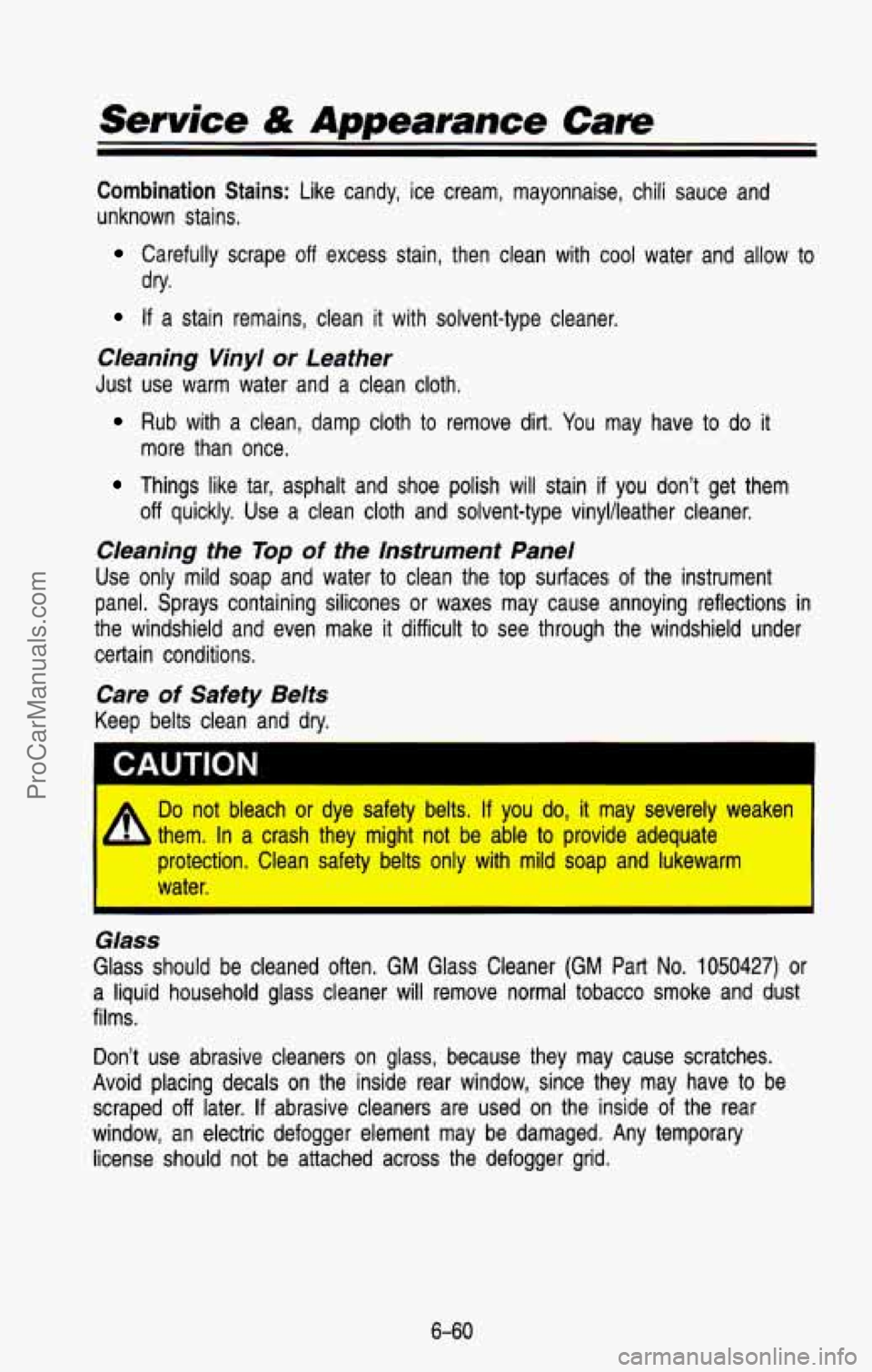
Service & Appearance Care
Combination Stains: Like candy, ice cream, mayonnaise, chili sauce and
unknown stains,
Carefully scrape off excess stain, then clean with cool water \
and allow to
If a stain remains, clean it with solvent-type cleaner.
dry.
Cleaning Vinyl or Leather
Just use warm water and a clean cloth.
Rub with a clean, damp cloth to remove dirt. You may have to do it
more than once.
Things like tar, asphalt and shoe polish will stain if you don’t get them
off quickly. Use a clean cloth and solvent-type vinylheather cleaner\
.
Cleaning the Top of the Instrument Panel
Use only mild soap and water to clean the top surfaces of th\
e instrument
panel. Sprays containing silicones or waxes may cause annoying \
reflections in
the windshield and even make
it difficult to see through the windshield under
certain conditions.
Care of Safety Belts
Keep belts clean and dry.
Do not bleach or dye safety belts. If you do, it may severely weaken
them. In a crash they might not be able to provide adequate
protection. Clean
safety belts only with mild soap and lukewarm
I water.
Glass
Glass should be cleaned often. GM Glass Cleaner (GM Part No. 1050427) or
a liquid household glass cleaner will remove normal tobacco smoke \
and dust
films.
Don’t use abrasive cleaners
on glass, because they may cause scratches.
Avoid placing decals on the inside rear window, since they may\
have to be scraped
off later. If abrasive cleaners are used on the inside of the rear
window, an electric defogger element may be damaged. Any temporary
iicense should not be attached across the defogger grid.
6-60
ProCarManuals.com
Page 328 of 386
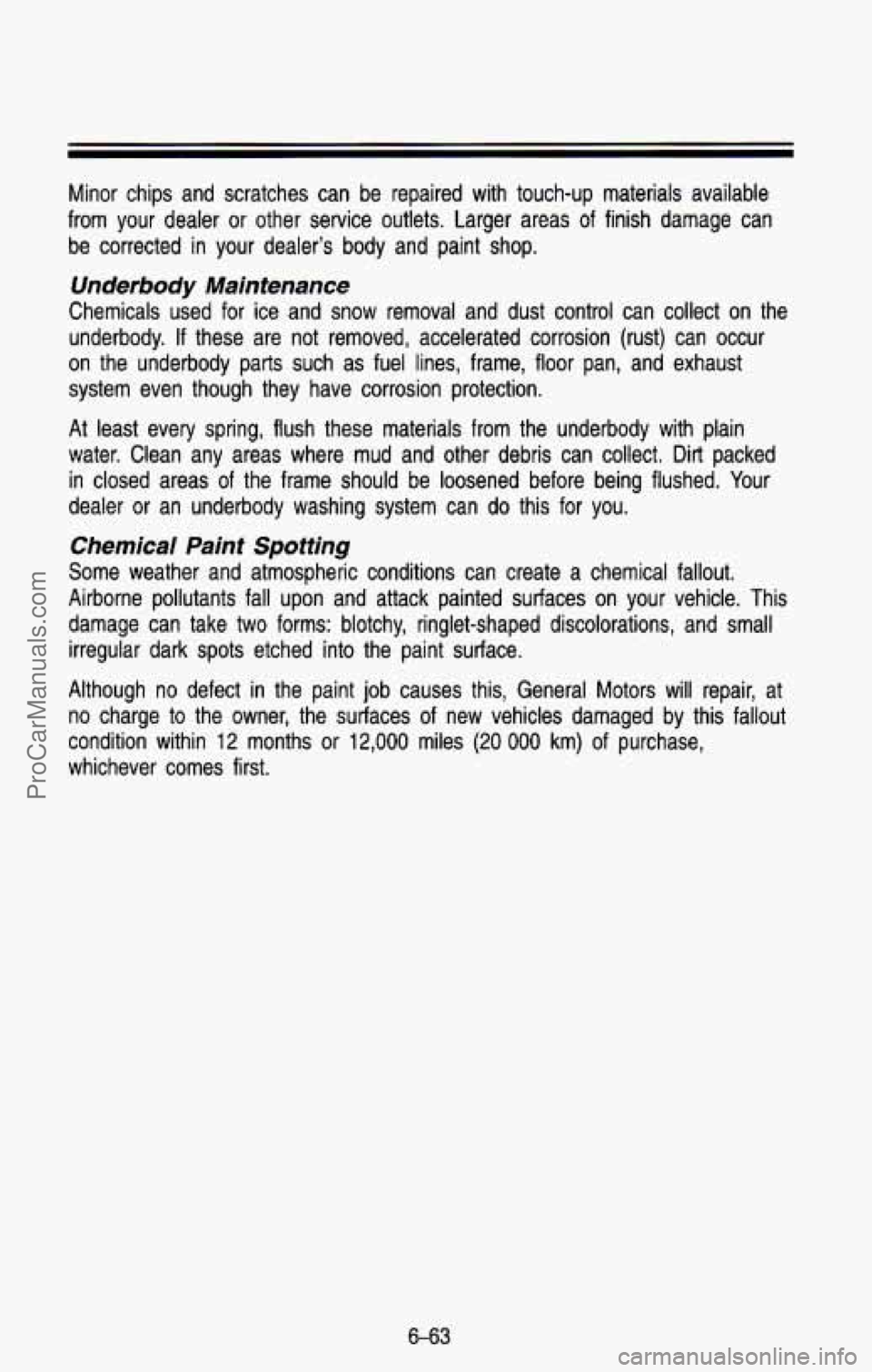
Minor chips and scratches can be repaired with touch-up materia\
ls available
from your dealer or other service outlets. Larger areas of fin\
ish damage can be corrected in your dealer’s body and paint shop.
Underbody Maintenance
Chemicals used for ice and snow removal and dust control can collect on the
underbody.
If these are not removed, accelerated corrosion (rust) can occur
on the underbody parts such as fuel lines, frame, floor pan, and exhaust
system even though they have corrosion protection.
At least every spring, flush these materials from the underbody wi\
th plain
water. Clean any areas where mud and other debris can collect.\
Dirt packed in closed areas of the frame should be loosened before being flushed. Your
dealer or an underbody washing system can do this for you.
Chemical Paint Spotting
Some weather and atmospheric conditions can create a chemical fallout.
Airborne pollutants fall upon and attack painted surfaces on yo\
ur vehicle. This
damage can take two forms: blotchy, ringlet-shaped discolorations\
, and small irregular dark spots etched into the paint surface.
Although no defect in the paint
job causes this, General Motors will repair, at
no charge to the owner, the surfaces of new vehicles damaged by \
this fallout
condition within
12 months or 12,000 miles (20 000 km) of purchase,
whichever comes first.
6-63
ProCarManuals.com
Page 329 of 386
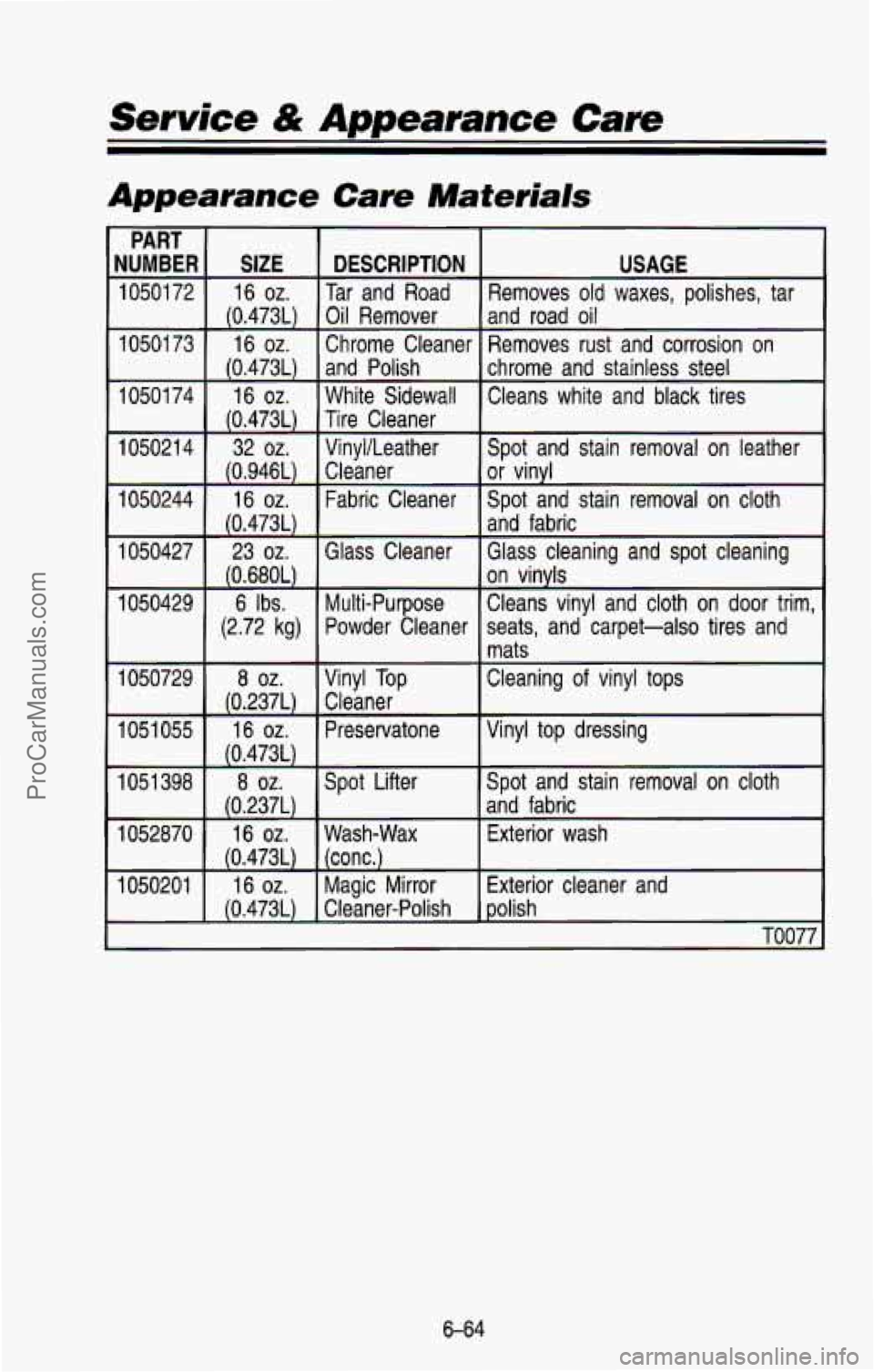
Service & Appearance Care
Appearance Care Materials
PART I I I
NUMBER SIZE DESCRIPTION USAGE
1050172 16 02. Tar and Road Removes old waxes, polishes, tar
1050173 16
oz. Chrome Cleaner Removes rust and corrosion on
I0501 74 16
02. White Sidewall Cleans white and black tires
(0.473L)
Oil Remover and road oil
(0.473L) and Polish chrome and stainless steel
(0.473L) Tire Cleaner
1050214 32
oz. VinvVLeather Spot and stain removal on leather
(0.946L) Cleaner or vinyl
(0.473L) and fabric
1050244 16 02. Fabric Cleaner Spot and stain removal on cloth
I050427 23
02. Glass Cleaner Glass cleanina and sDot cleaning I
(0.680L)
"
on vinyls
-
1050429 6 Ibs. Multi-PurDose Cleans vinvl and cloth on door tr\
im,
(2.72 kg) Powder cleaner seats, and'carpet-also tires and
mats
1050729 8
02. Vinyl Top
Cleaning of vinyl tops
1051
055 16 02. Preservatone Vinyl top dressing
IO51
398 8 02. Spot Lifter Spot and stain removal on cloth
1052870 16
02. Wash-Wax Exterior wash
(0.237L) Cleaner
(0.473L)
(0.237L)
and fabric
(0.473L) (conc.)
1050201 16
02. Magic Mirror Exterior cleaner and
I (0.473L) I Cleaner-Polish 1 polish
TO077
6-64
ProCarManuals.com
Page 330 of 386
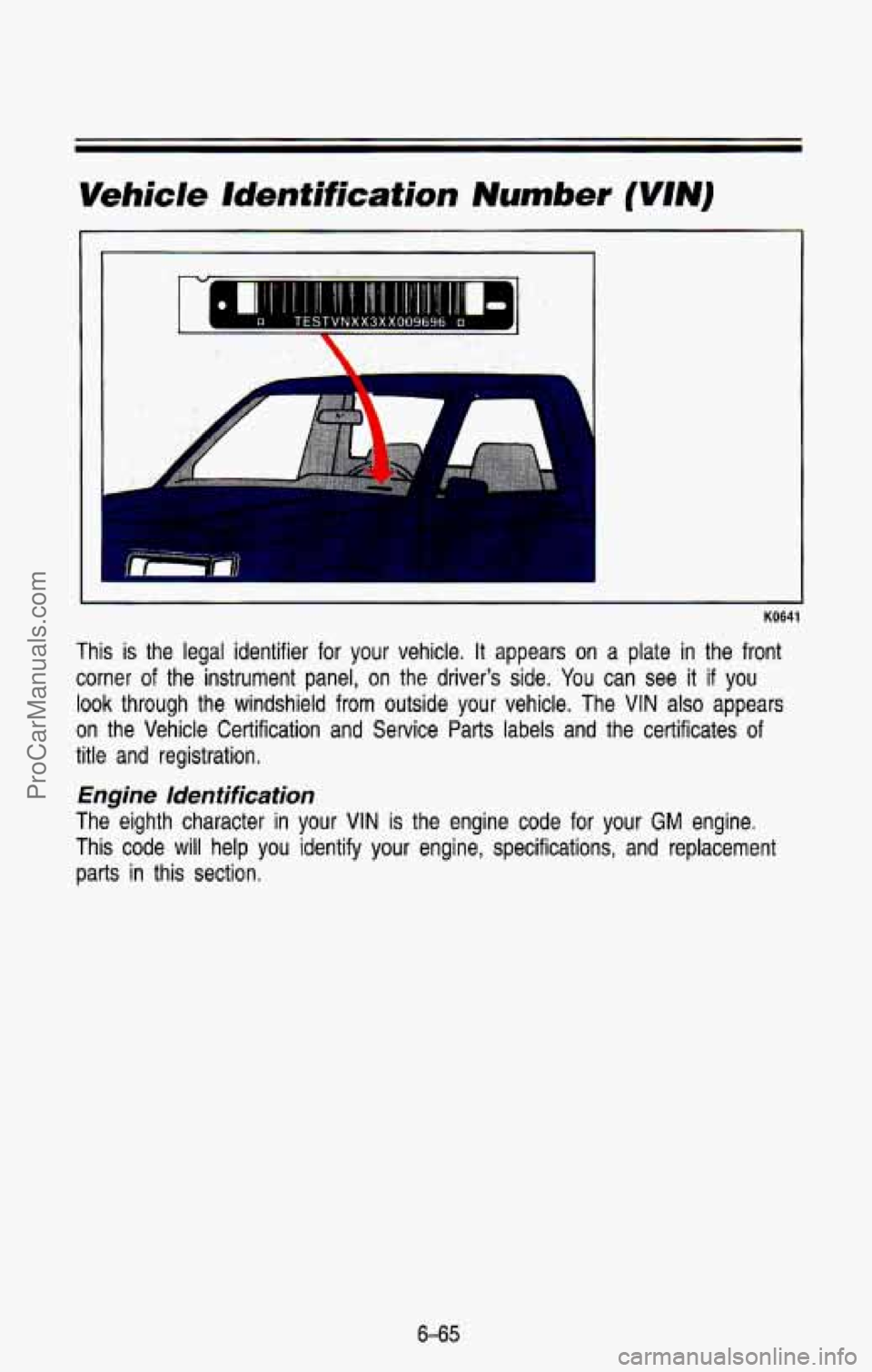
Vehicle ldentification Number ( I) m
t-
KO641
This is the legal identifier for your vehicle. It appears on a plate in the front
corner of the instrument panel,
on the driver's side. You can see it if you
look through the windshield from outside your vehicle. The VIN also appears
on the Vehicle Certification and Service Parts labels and the \
certificates
of
title and registration.
Engine Identification
The eighth character in your VIN is the engine code for your GM engine.
This code will help
you identify your engine, specifications, and replacement
parts in this section.
6-65
ProCarManuals.com